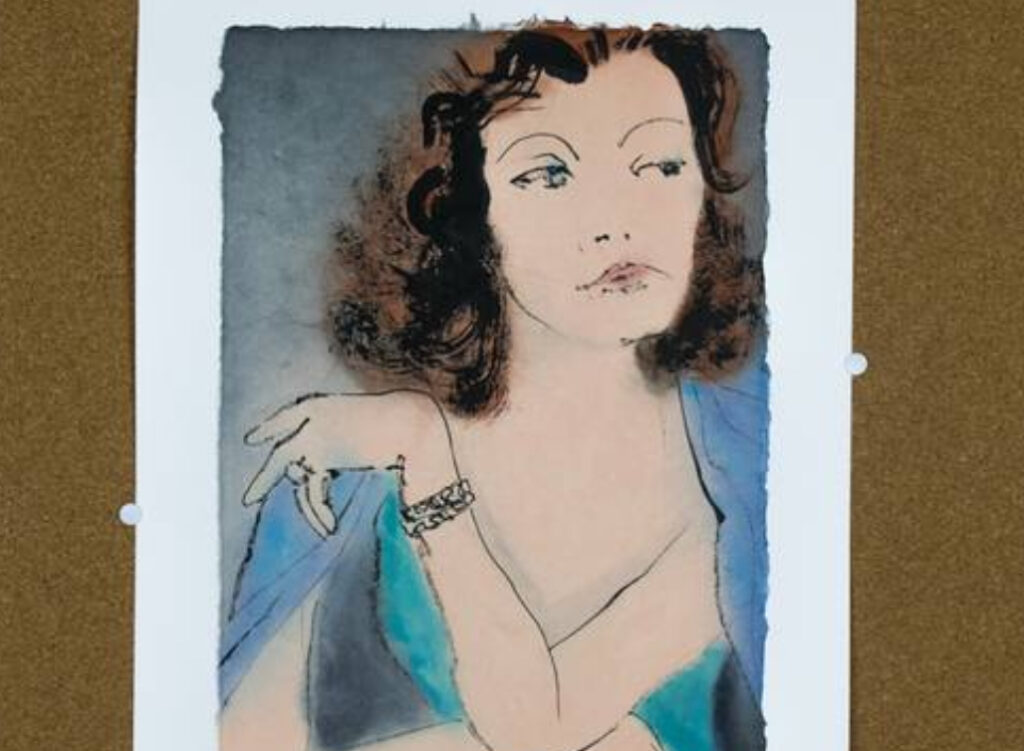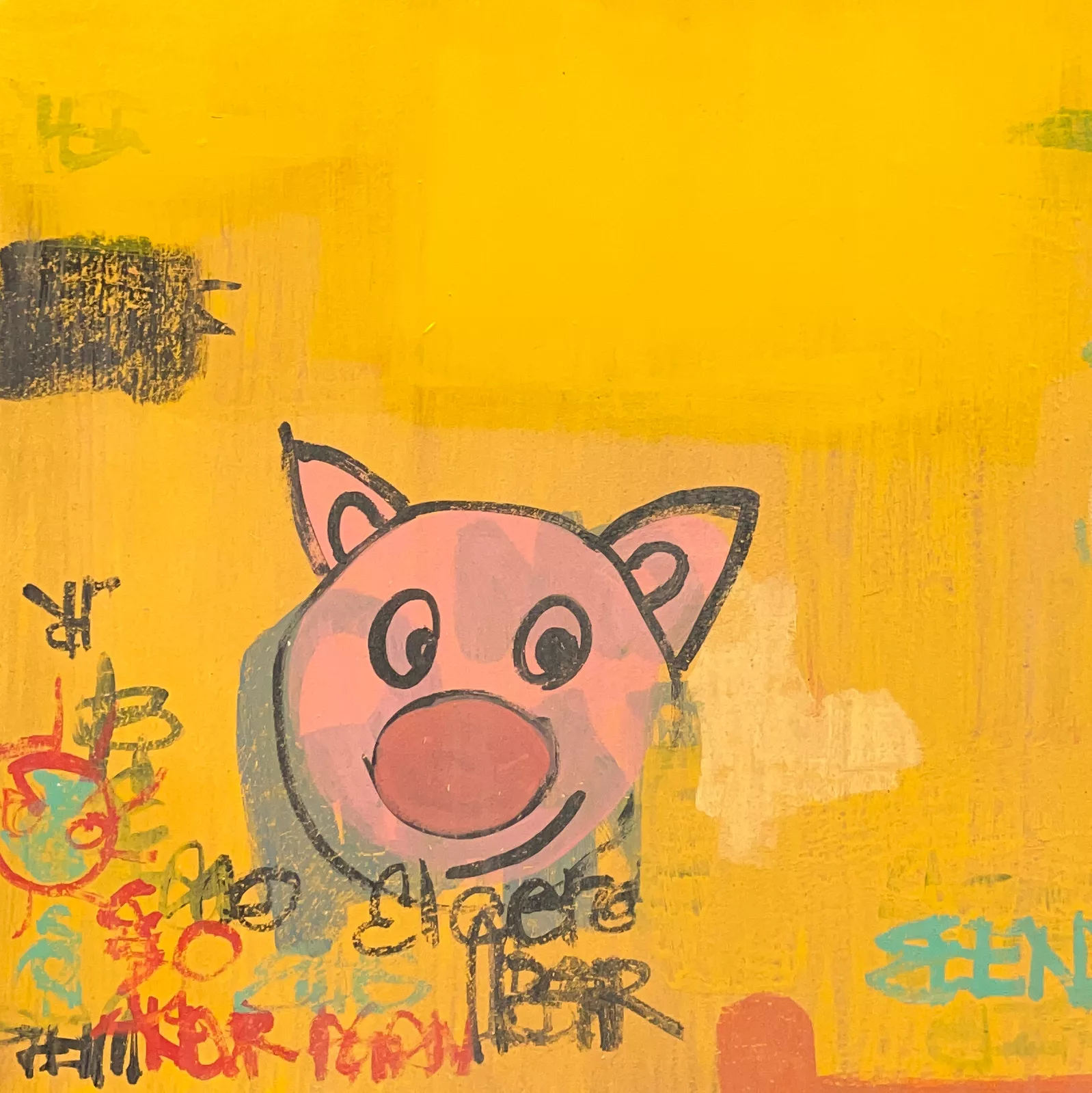Marcel Garbi, a London-based Spanish multidisciplinary artist, is known for his distinctive approach to visual art, incorporating elements of painting, illustration, and digital media. His piece Distinction stands out as an example of his ability to capture human expression and evoke emotional depth through delicate yet expressive techniques.
The artwork in question, Distinction, is an ink and watercolor composition on Japanese handmade paper, featuring a contemplative woman rendered in a style reminiscent of classical portraiture and early 20th-century fashion illustrations. The balance of controlled lines and free-flowing washes creates a compelling interplay between definition and ambiguity, contributing to the piece’s evocative nature. This discussion will analyze Distinction in terms of its composition, technique, historical influences, emotional impression, and how it fits within Garbi’s broader artistic vision.
The composition of Distinction is characterized by a minimal yet intentional arrangement. The woman, occupying the central space, is positioned slightly off-center, creating a subtle asymmetry that draws the viewer’s eye. Her facial features, although delicately drawn, remain somewhat abstract, allowing for an open-ended interpretation of her expression. The gaze, distant and introspective, suggests contemplation or quiet detachment.
Garbi’s technique in this piece combines ink drawing with watercolor washes. His use of ink for contouring and facial detailing demonstrates a controlled hand, yet he allows the lines to remain fluid and organic rather than rigid. This approach aligns with traditional Japanese sumi-e ink painting, where economy of line is emphasized over excessive detail.
The watercolor application, in contrast, brings softness and depth to the composition. The muted tones of blue and flesh contrast subtly against the dark hair and background, emphasizing the figure without overwhelming the composition. This interplay between ink and watercolor contributes to the artwork’s delicate yet expressive quality, giving the impression of fleeting emotion captured in a moment of stillness.
Additionally, the choice of Japanese handmade paper as the medium adds a distinct textural element. The natural fibers of washi paper absorb ink and pigment differently than conventional Western papers, creating an organic, slightly uneven distribution of color. This technique enhances the ethereal quality of the piece, reinforcing its dreamlike aura.
One of the most striking aspects of Distinction is the elegance conveyed through the subject’s posture and attire. The woman’s relaxed yet refined pose, with one hand gently resting and the other slightly raised, suggests sophistication. Her clothing, depicted in fluid strokes of blue, evokes a sense of luxury without excessive detailing. This stylistic choice aligns with classic portraiture traditions, where elegance and grace were often central themes.
Introspection and Mystery
The subject’s gaze is a crucial aspect of the painting’s emotional impact. Unlike direct engagement with the viewer, which is common in portraiture, the woman looks off to the side, lost in thought. This subtle detachment invites the viewer to speculate about her emotions and narrative. Is she reminiscing about a past moment? Is she assessing something just outside the frame? The ambiguity allows for personal interpretation, making the artwork emotionally engaging.
Feminine Identity and Representation
Garbi’s depiction of women in his artwork often reflects both classical beauty ideals and a modern sensibility. In Distinction, the woman is neither overtly idealized nor reduced to mere aesthetic appeal; instead, she exudes a quiet confidence. This portrayal aligns with evolving representations of femininity in contemporary art—where emotional depth, autonomy, and introspection take precedence over mere surface beauty.
The Passage of Time
There is a timeless quality to Distinction that makes it resonate beyond its immediate visual appeal. The combination of traditional ink and watercolor with modern artistic sensibilities gives it a sense of existing outside of any specific era. The choice of muted tones and a slightly aged paper texture further reinforces this, making the artwork feel like a rediscovered relic of the past, despite its contemporary creation.
Historical and Artistic Influences
Marcel Garbi’s work in Distinction demonstrates influences from several artistic traditions, blending elements of classical portraiture, Japanese ink painting, early 20th-century fashion illustration, and modern minimalism.
Classical Portraiture
The refined poise and subtle expressiveness in Distinction echo elements of European classical portraiture. Artists such as John Singer Sargent and Édouard Manet often depicted female subjects with a similar balance of elegance and introspection. In particular, Sargent’s watercolors showcase a comparable fluidity and mastery of light washes, where the subject emerges through restrained yet evocative brushwork.
Japanese Ink and Watercolor Traditions
Garbi’s choice of Japanese handmade washi paper and the controlled yet expressive use of ink suggest an affinity for East Asian painting techniques. Japanese sumi-e (ink wash painting) and ukiyo-e (woodblock prints) often emphasize minimal yet powerful brushwork. The way Garbi captures movement and form with limited but deliberate strokes echoes this philosophy.
Early 20th-Century Fashion Illustration
There is an undeniable link between Distinction and the elegant, expressive illustrations that dominated fashion magazines in the early 20th century. Artists such as René Gruau and Erté specialized in high-fashion portraiture that combined strong ink lines with delicate washes of color. The way Garbi renders his subject—particularly her posture, garment suggestions, and distant gaze—resonates with this tradition.
Modern Minimalism and Expressionism
Though steeped in classical influences, Distinction also bears elements of modern minimalism. The restrained color palette, sparse background, and lack of excessive detailing give the piece a contemporary feel. This approach allows the viewer to focus on the emotional presence of the subject rather than getting lost in decorative elements.
Emotional and Psychological Impact
What makes Distinction a compelling artwork is its ability to evoke an emotional response through minimal yet powerful visual cues. The subject’s detached gaze and subdued expression create an air of quiet introspection. This emotional subtlety is a hallmark of great portraiture—where the true impact is felt not through overt drama, but through nuanced storytelling.
The color choices also play a role in shaping the psychological atmosphere of the piece. The cool blues and warm flesh tones create a sense of calm and introspection, while the dark hair and shadows add depth and contrast. This balance prevents the artwork from feeling too light or too melancholic, instead maintaining a poised, contemplative mood.
Garbi’s use of handmade paper further enhances this emotional depth. The natural fibers and uneven texture introduce an organic quality to the piece, making it feel more intimate and unique compared to mass-produced, digitally manipulated images.
The Significance of Distinction in Marcel Garbi’s Work
Marcel Garbi’s Distinction is a masterful example of how ink, watercolor, and composition can work together to create a portrait that is both timeless and contemporary. Through elegant minimalism, refined technique, and emotional depth, the artwork invites viewers into a moment of quiet contemplation.
The piece’s synthesis of classical portraiture, Japanese artistic traditions, and modern minimalism showcases Garbi’s ability to bridge different artistic influences while maintaining a distinct personal style. Its thematic elements—introspection, feminine identity, and timeless elegance—make it a compelling study of human expression.
Ultimately, Distinction is more than just a visual representation of a woman; it is an exploration of grace, thoughtfulness, and the quiet power of subtle emotions. Garbi’s ability to capture this complexity through simple yet intentional brushwork speaks to his skill as an artist, making Distinction a noteworthy contribution to contemporary portraiture.
No comments yet.








